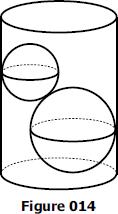Two balls
Two balls, one 8cm in radius and the other 6cm in radius, are placed in a cylindrical plastic container 10cm in radius. Find the volume of water necessary to cover them.
Final Answer:

Tips for related online calculators
Tip: Our volume units converter will help you convert volume units.
See also our right triangle calculator.
See also our trigonometric triangle calculator.
See also our right triangle calculator.
See also our trigonometric triangle calculator.
You need to know the following knowledge to solve this word math problem:
arithmeticsolid geometryplanimetricsUnits of physical quantitiesGrade of the word problem
Related math problems and questions:
- Cylindrical 16713
 Twenty identical steel balls were dropped into a cylindrical container of water standing on a horizontal surface to submerge them below the surface. At the same time, the water level rose by 4 mm. Determine the radius of one sphere if the diameter of the
Twenty identical steel balls were dropped into a cylindrical container of water standing on a horizontal surface to submerge them below the surface. At the same time, the water level rose by 4 mm. Determine the radius of one sphere if the diameter of the - Cylindrical 2945
 The cylindrical plastic container has a bottom diameter of 2 dm. How tall must the container be to hold 5 liters of water?
The cylindrical plastic container has a bottom diameter of 2 dm. How tall must the container be to hold 5 liters of water? - The cylindrical container
 The cylindrical container has a base area of 300 cm³ and a height of 10 cm. It is 90% filled with water. We gradually insert metal balls into the water, each with a volume of 20 cm³. After inserting, how many balls does water flow over the edge of the con
The cylindrical container has a base area of 300 cm³ and a height of 10 cm. It is 90% filled with water. We gradually insert metal balls into the water, each with a volume of 20 cm³. After inserting, how many balls does water flow over the edge of the con - Cylindrical container
 An open-topped cylindrical container has a volume of V = 3140 cm³. Find the cylinder dimensions (radius of base r, height v) so that the least material is needed to form the container.
An open-topped cylindrical container has a volume of V = 3140 cm³. Find the cylinder dimensions (radius of base r, height v) so that the least material is needed to form the container. - Marbles 4
 Sipho has a cylindrical tank with a radius of 8cm and a height of 10cm. The bottom of the tank is filled with marbles, and the tank is then filled with water to a height of 6,4 cm. When the marbles are removed, the water level drops to 4cm. Using the info
Sipho has a cylindrical tank with a radius of 8cm and a height of 10cm. The bottom of the tank is filled with marbles, and the tank is then filled with water to a height of 6,4 cm. When the marbles are removed, the water level drops to 4cm. Using the info - Cylindrical 7891
 Is it possible to pour water from a full cube-shaped container measuring 8 cm, 10 cm, and 12 cm into a cylindrical container with a bottom diameter of 12 cm and a height of 8 cm?
Is it possible to pour water from a full cube-shaped container measuring 8 cm, 10 cm, and 12 cm into a cylindrical container with a bottom diameter of 12 cm and a height of 8 cm? - Container
 The container has a cylindrical shape, the base diameter is 0.8 m, and the area of the base is equal to the area of the wall. How many liters of water can we pour into the container?
The container has a cylindrical shape, the base diameter is 0.8 m, and the area of the base is equal to the area of the wall. How many liters of water can we pour into the container?
